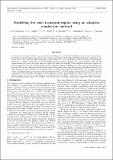Files in this item
Modelling the solar transition region using an adaptive conduction method
Item metadata
| dc.contributor.author | Johnston, C. D. | |
| dc.contributor.author | Cargill, P. J. | |
| dc.contributor.author | Hood, A. W. | |
| dc.contributor.author | De Moortel, I. | |
| dc.contributor.author | Bradshaw, S. J. | |
| dc.contributor.author | Vaseekar, A. C. | |
| dc.date.accessioned | 2020-02-26T13:30:13Z | |
| dc.date.available | 2020-02-26T13:30:13Z | |
| dc.date.issued | 2020-03 | |
| dc.identifier | 266508413 | |
| dc.identifier | 0af45a82-c559-4ecb-95c7-a1f3c145b775 | |
| dc.identifier | 85082864616 | |
| dc.identifier | 000526214700002 | |
| dc.identifier.citation | Johnston , C D , Cargill , P J , Hood , A W , De Moortel , I , Bradshaw , S J & Vaseekar , A C 2020 , ' Modelling the solar transition region using an adaptive conduction method ' , Astronomy & Astrophysics , vol. 635 , A168 . https://doi.org/10.1051/0004-6361/201936979 | en |
| dc.identifier.issn | 0004-6361 | |
| dc.identifier.other | BibCode: 2020arXiv200201887J | |
| dc.identifier.other | BibCode: 2020A&A...635A.168J | |
| dc.identifier.other | ORCID: /0000-0002-1452-9330/work/72842019 | |
| dc.identifier.other | ORCID: /0000-0003-2620-2068/work/72842096 | |
| dc.identifier.other | ORCID: /0000-0003-4023-9887/work/72842694 | |
| dc.identifier.uri | https://hdl.handle.net/10023/19538 | |
| dc.description | Funding: European Union Horizon 2020 research and innovation programme (grant agreement No. 647214); the UK Science and Technology Facilities Council through the consolidated grant ST/N000609/1. | en |
| dc.description.abstract | Modelling the solar Transition Region with the use of an Adaptive Conduction (TRAC) method permits fast and accurate numerical solutions of the field-aligned hydrodynamic equations, capturing the enthalpy exchange between the corona and transition region, when the corona undergoes impulsive heating. The TRAC method eliminates the need for highly resolved numerical grids in the transition region and the commensurate very short time steps that are required for numerical stability. When employed with coarse spatial resolutions, typically achieved in multi-dimensional magnetohydrodynamic codes, the errors at peak density are less than 5% and the computation time is three orders of magnitude faster than fully resolved field-aligned models. This paper presents further examples that demonstrate the versatility and robustness of the method over a range of heating events, including impulsive and quasi-steady footpoint heating. A detailed analytical assessment of the TRAC method is also presented, showing that the approach works through all phases of an impulsive heating event because (i) the total radiative losses and (ii) the total heating when integrated over the transition region are both preserved at all temperatures under the broadening modifications of the method. The results from the numerical simulations complement this conclusion. | |
| dc.format.extent | 19 | |
| dc.format.extent | 3856307 | |
| dc.language.iso | eng | |
| dc.relation.ispartof | Astronomy & Astrophysics | en |
| dc.subject | Hydrodynamics | en |
| dc.subject | Magnetohydrodynamics (MHD) | en |
| dc.subject | Sun: transition region | en |
| dc.subject | Sun: chromosphere | en |
| dc.subject | Sun: corona | en |
| dc.subject | Sun: flares | en |
| dc.subject | QB Astronomy | en |
| dc.subject | QC Physics | en |
| dc.subject | T-NDAS | en |
| dc.subject | BDC | en |
| dc.subject.lcc | QB | en |
| dc.subject.lcc | QC | en |
| dc.title | Modelling the solar transition region using an adaptive conduction method | en |
| dc.type | Journal article | en |
| dc.contributor.sponsor | Science & Technology Facilities Council | en |
| dc.contributor.sponsor | European Research Council | en |
| dc.contributor.sponsor | The Royal Society | en |
| dc.contributor.institution | University of St Andrews. Applied Mathematics | en |
| dc.contributor.institution | University of St Andrews. School of Mathematics and Statistics | en |
| dc.identifier.doi | 10.1051/0004-6361/201936979 | |
| dc.description.status | Peer reviewed | en |
| dc.identifier.url | http://adsabs.harvard.edu/abs/2020A%26A...635A.168J | en |
| dc.identifier.grantnumber | ST/N000609/1 | en |
| dc.identifier.grantnumber | 647214 | en |
| dc.identifier.grantnumber | RSWF\FT\180005 | en |
This item appears in the following Collection(s)
Items in the St Andrews Research Repository are protected by copyright, with all rights reserved, unless otherwise indicated.

